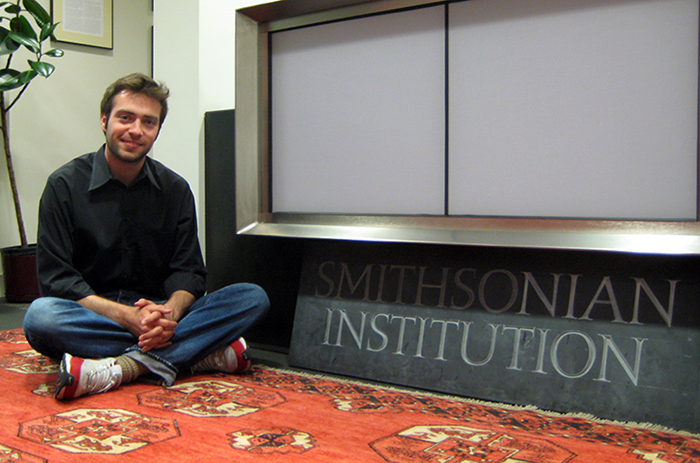On a hot afternoon in June 2008, I stood under a large tent at the Smithsonian Folklife Festival, ready for the day’s work. As an intern for Smithsonian Folkways, I was to inform customers about our label’s recordings and sell CDs. I often heard behind-the-scenes stories about Folkways’ releases, and the Festival was the perfect opportunity to share them.
A woman approached me wanting to know more about Iraqi musician Rahim Alhaj’s 2006 release, When the Soul Is Settled: Music of Iraq. I shared the story: it was a response to the Iraq War. Folkways curators wanted to present a “humanized” portrait of Iraqi life, as, at the time, American media painted Iraq as a land with weapons of mass destruction. The taqsims of Alhaj (oud) and Souhail Kaspar (percussion) were beautiful statements of tradition, innovation, and the human need to create—antithetical to what CNN led us to believe. The story brought a tear to the woman’s eye, and she purchased the recording.
I share this moment for two reasons. First, my internship at Smithsonian Folkways convinced me that music was a powerful tool for understanding the people of the world. Second, it showed me how to put this idea into practice. Now, as a professional ethnomusicologist, I credit this internship with planting the seeds to cultivate a career.

As an intern, I worked closely with Atesh Sonneborn, associate director of Smithsonian Folkways. My interaction with Atesh was a daily crash-course in balancing artistic sensibilities and organizational realities—an invaluable lesson in our profession. I paid close attention to how he worked as a culture broker with artists, scholars, and music industry professionals.
These observations were vital in my later position as the South Carolina Folklife and Traditional Arts Program Director at McKissick Museum (University of South Carolina) and the South Carolina Arts Commission. There, I often found own my balance by asking: what did Atesh do in a similar situation?
Three projects were highlights of my work with him. My first publication was the song notes for American Roots Music (with Richard Carlin)—an album compiled by Folkways and released by the U.S. State Department. In addition, I curated music for an African American History Month exhibition and edited a video tribute to former Folkways Canadian distributor, Sam Gesser.

Good memories abound from the Smithsonian Folklife Festival. I befriended numerous artists from Bhutan—one of 2008’s three featured programs—whom I still call friends today. At my family gatherings, the story of meeting His Royal Highness Prince Jigyel Ugyen Wangchuck of Bhutan never grows old.
I have vivid memories of selling Folkways recordings at special events. One such gathering was a screening of the film The Accordion Kings, along with a performance by musicians from ¡Ayombe!: The Heart of Colombia’s Música Vallenata at the National Museum of Natural History. Their infectious rhythms and energetic accordions had the audience dancing out of the auditorium and yelling at us with outstretched hands, “Dame uno! Dame uno!” (“Give me a CD! Give me a CD!”)
My Folkways internship led to a number of professional positions. In September 2008, I was hired as the music supervisor for a documentary film, Worlds of Sound: The Ballad of Folkways, which traced the history of the label through interviews with artists, staff, and, of course, music. Next, I was hired to assist the Future of Music Coalition with a report about indigenous musicians in United States, Australia, Kyrgyzstan, and Tajikistan. Since Folkways curatorial staff was interviewed for the project, I was well fit for the position.

A continual outcome of the internship experience has been a growing network of former Folkways interns. These contacts are not just those with whom I worked first-hand, but comprise a large community of past interns, who are now professionals in music, cultural heritage, folklore, and arts administration. Just the other day, I discovered that I held the same Folkways internship as an assistant professor on my Ph.D. committee. A small world, it is indeed.
Moving forward on my career path, I look back with gratitude to my internship at Smithsonian Folkways. The ideas, experiences, and relationships gained have been integral to my career in the field of ethnomusicology. Said another way—the seeds planted during my internship are still bearing fruit.
Douglas Dowling Peach is a Ph.D. graduate student in ethnomusicology at Indiana University-Bloomington. He is the co-author, with Henry Glassie and Clifford Murphy, of Ola Belle Reed and Southern Mountain Music on the Mason-Dixon Line (Dust-to-Digital), and is the former Folklife and Traditional Arts Program Director at McKissick Museum (University of South Carolina) and the South Carolina Arts Commission.


